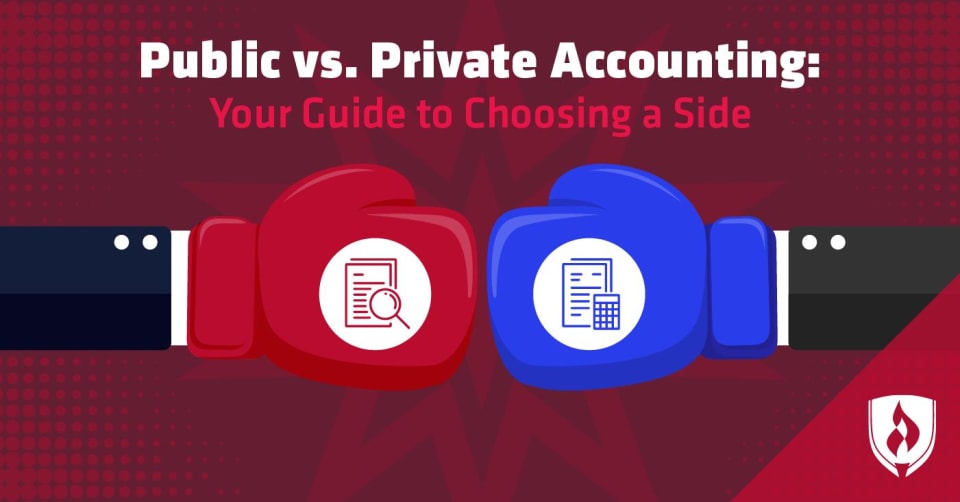
Everywhere you turn, people are making leaps into incredible, satisfying careers. Your friends are announcing new jobs on social media and your favorite blogs are constantly featuring stories of people who landed the job of their dreams.
Now it’s your turn. You’ve been toying with the idea of a career change for a while, and your excitement is building. You’ve done the research and know that your detail-oriented, analytical personality is a perfect fit for the world of accounting. But your research also tells you there’s another decision ahead—whether to focus your career on public versus private accounting.
So what’s the difference between these branches of accounting and which option is best for you? A career in accounting sounds better every day, but you need to be sure you choose the path that works for you and your family. To help, we created this handy guide to help you decide if you’re better suited for public or private accounting.
Defining public accounting and private accounting
Before we get too far along in comparing private and public accounting, let’s take a moment to cover the basics.
What is public accounting?
Public accounting is the branch of accounting where an accountant works with a range of clients to review and prepare financial documents that an individual or corporation is required to disclose to the public. In simple terms, public accountants work to verify important financial documents, reports and disclosures from an outside perspective.
What is private accounting?
Private accountants, on the other hand, deal with the financial information of a single company they’re employed by, usually preparing or analyzing reports for an internal manager. Often the work of private accounting professionals is reviewed and audited by public accounting firms—this provides a sort of independent stamp of approval verifying that their private internal accounting practices meet reporting standards.
Public vs. private accounting: A closer look to compare
On paper, the distinction between these two sectors of accounting may sound relatively minor. But this simple difference can make a big impact on what your life as an accountant could look like. Let’s take a closer look at some of the biggest factors to see whether you’re better suited for public or private accounting.
Work environment
Both public and private accountants have their busy times, whether it’s tax season for public accountants or the end of a financial quarter for private accountants. But beyond that, the two work environments can vary quite a bit.
“The biggest thing you need to know about environments if you’re weighing public versus private accounting is the travel,” says Eric Butts, CPA and advisory manager at PricewaterhouseCoopers.
Private accountants work for a single company. They can expect to work fairly regular hours in the comfort of the office their boss assigns to them. This option very much resembles a “typical” office job.
A public accountant’s work environment isn’t quite as predictable. They often own their own businesses or work for public accounting firms. They work with a wide variety of clients—from individuals to corporations, and potentially even the government. Public accountants travel to wherever their clients are located. They do their work wherever a client has space for them and they are often under the pressure of strict deadlines—which can lead to long workdays.
Day-to-day job duties
Many people assume one accounting job is the same as the next, but these different areas of accounting make for job duties that are worlds apart.
What do public accountants do? Public accountants are responsible for ensuring that their clients’ financial documents are accurate and complete before being released to the public. Their daily job duties usually center on testing and analyzing the financial information their clients have prepared to make certain they’re error-free, according to Butts.
Public accountants will often choose a specialty—such as tax accounting, auditing, forensic accounting or consulting—that comes with specific job duties as well.
What do private accountants do? Private accountants work with internal business or financial managers to plan their company’s cost of doing business and to evaluate fiscal performance.
“[Private accountants’] daily activities revolve primarily around management reporting. This includes recording manual journal entries and performing account reconciliations,” Butts says.
Education requirements
A Bachelor’s degree in Accounting is a requirement for both private and public accountants, according to the Bureau of Labor Statistics (BLS).* Beyond that, the most popular accounting credential is the license to become a Certified Public Accountant, or CPA.
CPAs are licensed in their state to file reports with the Securities and Exchange Commission. They must pass a national exam, meet education requirements and maintain ongoing education and training. The BLS states that employers will often cover the cost of the CPA exam for their employees.*
Public accountants need a CPA in order to advance to the manager level, but the same does not hold true for private accountants, according to Butts. That being said, a CPA license is usually more valuable to public accountants than private.
Even still, a CPA license can give any accountant a leg up in their career—even those in the private industry. If opening your own accounting firm interests you, this credential will show clients you’re knowledgeable and professional.
A CPA may be the most commonly known accounting license, but there’s a whole host of certification options for accountants to fit your specific career goals.
Public vs. private accounting: Pros & cons
Both of these career paths have advantages and disadvantages. Consider these pros and cons before making your decision.
Pros of public accounting
- Job advancement opportunities may come sooner
- Allows for specialization
- Greater variety of exposure in working with different clients and industries
Cons of public accounting
- More pressure and deadlines
- Work hours
- Possibility of inconvenient travel
Pros of private accounting
- Less stressful
- Steady, flexible work environment
- Can reach management level without a CPA license
Cons of private accounting
- Lack of variety in job duties
- Advancement opportunities may not come as quickly
- Fewer opportunities to specialize
It’s important to remember that while this is a side-by-side comparison, the path you choose doesn’t have to be permanent. The reality is that many accountants don’t just stick with one route or the other. For instance, it’s fairly common to see new accountants begin working for large public accounting firms where they’ll work long hours as they pursue their CPA license.
Eventually these accountants transition into a private accounting role where the demands of the job can be a little more accommodating. That being said, plenty stick with public accounting roles their entire careers and love the work—and potential for growth it brings. It all comes down to which best suits your style.
Which accounting career path will you follow?
Now that you know more about the ins and outs of public versus private accounting, you should be able to determine which path is best for your future.
No matter which type of accounting is the job of your dreams, there’s a degree program to help get you there. If you’re ready to take the next step, visit the Accounting degree page to learn more about what Rasmussen College has to offer.
Rasmussen University’s Accounting Certificate, Accounting Associate’s and Accounting Bachelor’s degree programs are not designed to prepare graduates for any state-issued professional license or certification. Rasmussen University’s Accounting Certificate, Accounting Associate’s and Accounting Bachelor’s degree programs do not meet all educational prerequisites for licensure as a Certified Public Accountant (CPA) in any state. Each state determines its own requirements. Please consult with your state’s board of accountancy or equivalent oversight agency for further details. Rasmussen University’s Accounting Certificate, Accounting Associate’s and Accounting Bachelor’s degree programs have not been approved by any state board of accountancy or other professional licensing agency. The coursework in Rasmussen University’s Accounting Bachelor’s degree program is aligned with the standards of the Institute of Management Accountants (IMA®) and meets the academic requirements to sit for the Certified Management Accountant (CMA®) exam. Additional requirements, such as work experience in a management accounting role, may be required to sit for the CMA® exam. Please consult the IMA® for any further details.
*Bureau of Labor Statistics, U.S. Department of Labor, Occupational Outlook Handbook, [career information accessed June 21, 2018] www.bls.gov/ooh/.
EDITOR’S NOTE: This article was originally published in June 2015. It has since been updated. Insights from Eric Butts remain from the original article.




